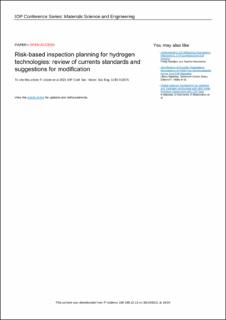| dc.contributor.author | Ustolin, Federico | |
| dc.contributor.author | Wan, Di | |
| dc.contributor.author | Alvaro, Antonio | |
| dc.contributor.author | Paltrinieri, Nicola | |
| dc.date.accessioned | 2022-05-10T06:45:38Z | |
| dc.date.available | 2022-05-10T06:45:38Z | |
| dc.date.created | 2021-12-16T16:02:43Z | |
| dc.date.issued | 2021 | |
| dc.identifier.citation | IOP Conference Series: Materials Science and Engineering. 2021, 1193 . | en_US |
| dc.identifier.issn | 1757-8981 | |
| dc.identifier.uri | https://hdl.handle.net/11250/2994912 | |
| dc.description.abstract | The research addressing loss of integrity (LOI) for hydrogen containment technologies requires a multidisciplinary perspective. However, lack of collaboration between materials and process safety engineers is reflected in the theory addressing the LOI phenomena. Even though the potential degrading mechanisms related to hydrogen-metals interaction are being extensively studied, they are not explicitly considered by standards and recommended practices in relation to plant inspection planning. This inevitably introduces additional uncertainties while planning for inspections and predictive maintenance and leads to the necessity to address and consider generic mechanisms of material degradation within the framework of LOI development prediction. A review of the available standards and recommended practices for inspection planning is here conducted to identify how metal-hydrogen interactions are currently considered in terms of degradation mechanisms. Focus is given to risk-based approaches, which include the assessment of potential accident scenarios as consequence of LOI. In particular, the association of metal-hydrogen mechanisms with damage factors influencing the predicted LOI frequency is studied to understand their impact both on the risk and the inspection typology. Appropriate knowledge of material degradation mechanisms for hydrogen containment is of paramount importance as it allows not only for a correct design of the equipment of interest, but also for a suitable inspection and maintenance planning so to guarantee its integrity through an effective and informed risk-based approach. A few modifications to the current standards are suggested as a result of this work. | en_US |
| dc.language.iso | eng | en_US |
| dc.publisher | IOP Publishing | en_US |
| dc.rights | Navngivelse 4.0 Internasjonal | * |
| dc.rights.uri | http://creativecommons.org/licenses/by/4.0/deed.no | * |
| dc.title | Risk-based inspection planning for hydrogen technologies: review of currents standards and suggestions for modification | en_US |
| dc.type | Journal article | en_US |
| dc.type | Peer reviewed | en_US |
| dc.description.version | publishedVersion | en_US |
| dc.source.pagenumber | 8 | en_US |
| dc.source.volume | 1193 | en_US |
| dc.source.journal | IOP Conference Series: Materials Science and Engineering | en_US |
| dc.identifier.doi | 10.1088/1757-899X/1193/1/012075 | |
| dc.identifier.cristin | 1969564 | |
| cristin.ispublished | true | |
| cristin.fulltext | original | |
| cristin.qualitycode | 1 | |

